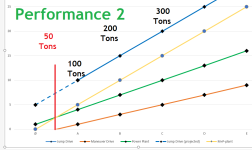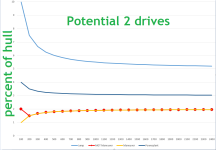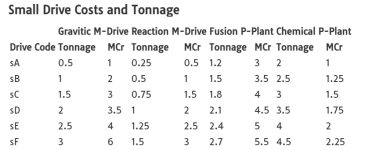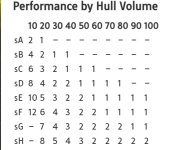You are using an out of date browser. It may not display this or other websites correctly.
You should upgrade or use an alternative browser.
You should upgrade or use an alternative browser.
Small craft drives.
- Thread starter spank
- Start date
Kakistocrat
SOC-12
There’s an article on Freelance Traveller called Modified Small Craft that was intended for use with CT, but nothing in that article was expressed in tabular form.Mongoose Traveller has a nifty table for small craft drives, it is also in the SRD.
I’ve seen something similar on Freelance Traveller.
Was this ever published for CT?
Spinward Flow
SOC-14 5K
No need for a table when an extremely obvious and simple formula works just as well (values in bold text are explicitly printed in LBB2.81 and repeated in TTB tables).There are threads here where people have theorycrafted that a plain old A plant/mdrive gets wedged into a small craft and gets the small craft results.
Maneuver-A = code: 1 @ 200 tons, code: 2 @ 100 tons, code: 3 @ 66 tons, code: 4 @ 50 tons, code: 5 @ 40 tons, code: 6 @ 33 tons.
Maneuver-B = code: 1 @ 400 tons, code: 2 @ 200 tons, code: 3 @ 133 tons, code: 4 @ 100 tons, code: 5 @ 80 tons, code: 6 @ 66 tons.
Maneuver-C = code: 1 @ 600 tons, code: 2 @ 300 tons, code: 3 @ 200 tons, code: 4 @ 150 tons, code: 5 @ 120 tons, code: 6 @ 100 tons.
Power Plant-A = 2 EP.
Power Plant-B = 4 EP.
Power Plant-C = 6 EP.
Drive-D and up "do not work" in hulls between 1-100 tons (as per LBB2.81), so you can't put a Power Plant-D into a small craft (for example) and get 8 EP out of it.
After that, everything is relatively straightforward, as far as the drives themselves are concerned.
Fuel consumption (per CT Beltstrike) is 1 ton of fuel per 2000 tons of craft per 7 days for "basic power" ... while EP (used for computer, weapons, agility, maneuver drive/agility, etc.) is 0.35 tons of fuel per 1 EP per 7 days. So a small craft can "get by" with a fuel tank of 1 ton of fuel reserve while not generating EPs (above "basic power" output) for an extremely long duration, just coasting/drifting, if necessary. However, longer journeys (more than 12-24 hours) will require Small Craft Cabin life support for crew/passengers. So you can "kinda sorta" throw away the 10Pn fuel requirement for LBB2.81 standard drives when installing them into small craft (since they don't jump and don't "need" the extra margin against mishap in foreign star systems that starships do).
Note: this and the next post are a reprise of something I posted here a while back. It was just easier to pull from my notes than to link it...
The basic problem is that interpolations based on the Size A Drives doesn't work properly below 200 rating points (Gs x tons or Pn x tons). Results below 200 rating points become increasingly implausible; at 100 rating points (1G in a 100 ton hull) the maneuver drive has zero tons displacement...
The underlying formulae for maneuver drives are:
Maneuver Drive:
M = Hull Tons, G = Acceleration in Gs
M must be between 100 and 5000 inclusive.
Note: values of M*G less than 100 yield negative drive tonnage! (Values below 200 get weird when you try to figure out Gs per ton of maneuver drive. Just don't go there, ok?)
If M=100, G must be divisible by two; if an odd G is desired, calculate drive size and cost using the next higher G divisible by 2. Drive capability and power requirements are based on the intended drive rating.
If M < 1000 but not evenly divisible by 200, round M up to the next multiple of 200 before calculating drive tonnage.
If M > 1000 but not evenly divisible by 1000, round M up to the next multiple of 1000 before calculating drive tonnage.
This rounding up does not affect fuel consumption calculations.
Maneuver Drive (tons) = (0.01*M*G)-1
Maneuver Drive (percent of M) = ((0.01*M*G)-1/M)*100
Cost = MCr0.02*M*G
Cost per ton = MCr2*(MD tons+1)
If M=2000 and G=1, subtract 2Td and MCr4.
If M*G>4000, consult table as exceptions may be present
------
For power plants:
Power Plant:
M = Hull tons, Pn = Power Plant Number
M must be between 100 and 5000 inclusive.
If M=100, Pn must be divisible by two; if an odd Pn is desired, calculate drive size and cost using the next higher Pn divisible by 2. Powerplant fuel consumption and output is based on the intended Pn.
If M < 1000 but not evenly divisible by 200, round M up to the next multiple of 200 before calculating drive tonnage.
If M > 1000 but not evenly divisible by 1000, round M up to the next multiple of 1000 before calculating drive tonnage.
This rounding up does not affect fuel consumption calculations.
Power Plant (tons) = (0.015*M*Pn)+1
Power Plant (percent of M) = ( (0.015*M*Pn+1)/M )*100
Cost = MCr0.04*M*Pn
Cost per ton = MCr2.67*(PP tons-1)
If M=2000 and Pn=1, subtract 3Td and MCr8.
If M*G>4000, consult table as exceptions may be present.
----
It's similar for Jump Drives, but that's off the topic.
The basic problem is that interpolations based on the Size A Drives doesn't work properly below 200 rating points (Gs x tons or Pn x tons). Results below 200 rating points become increasingly implausible; at 100 rating points (1G in a 100 ton hull) the maneuver drive has zero tons displacement...
The underlying formulae for maneuver drives are:
Maneuver Drive:
M = Hull Tons, G = Acceleration in Gs
M must be between 100 and 5000 inclusive.
Note: values of M*G less than 100 yield negative drive tonnage! (Values below 200 get weird when you try to figure out Gs per ton of maneuver drive. Just don't go there, ok?)
If M=100, G must be divisible by two; if an odd G is desired, calculate drive size and cost using the next higher G divisible by 2. Drive capability and power requirements are based on the intended drive rating.
If M < 1000 but not evenly divisible by 200, round M up to the next multiple of 200 before calculating drive tonnage.
If M > 1000 but not evenly divisible by 1000, round M up to the next multiple of 1000 before calculating drive tonnage.
This rounding up does not affect fuel consumption calculations.
Maneuver Drive (tons) = (0.01*M*G)-1
Maneuver Drive (percent of M) = ((0.01*M*G)-1/M)*100
Cost = MCr0.02*M*G
Cost per ton = MCr2*(MD tons+1)
If M=2000 and G=1, subtract 2Td and MCr4.
If M*G>4000, consult table as exceptions may be present
------
For power plants:
Power Plant:
M = Hull tons, Pn = Power Plant Number
M must be between 100 and 5000 inclusive.
If M=100, Pn must be divisible by two; if an odd Pn is desired, calculate drive size and cost using the next higher Pn divisible by 2. Powerplant fuel consumption and output is based on the intended Pn.
If M < 1000 but not evenly divisible by 200, round M up to the next multiple of 200 before calculating drive tonnage.
If M > 1000 but not evenly divisible by 1000, round M up to the next multiple of 1000 before calculating drive tonnage.
This rounding up does not affect fuel consumption calculations.
Power Plant (tons) = (0.015*M*Pn)+1
Power Plant (percent of M) = ( (0.015*M*Pn+1)/M )*100
Cost = MCr0.04*M*Pn
Cost per ton = MCr2.67*(PP tons-1)
If M=2000 and Pn=1, subtract 3Td and MCr8.
If M*G>4000, consult table as exceptions may be present.
----
It's similar for Jump Drives, but that's off the topic.
Last edited:
One trick is to bundle the maneuver drive with the power plant before scaling the tonnage. The +1 from the power plant tonnage formula cancels the -1 in the maneuver drive formula, and then it becomes a straight percentage that scales easily.
It's not clear how this would work mechanically under any rules's "flavor text" later than HG 1st Ed. (that is, after M-Drives were retconned into being pure grav drives rather than a thrust-producing accessory to the power plant), but the math works out.
Energy points aren't tracked in this system, since they hadn't yet been invented... You can add tonnage to the power plant component of the "combined drives," or add an actual power plant, to generate them if you're porting this to a system that does use them.
It's not clear how this would work mechanically under any rules's "flavor text" later than HG 1st Ed. (that is, after M-Drives were retconned into being pure grav drives rather than a thrust-producing accessory to the power plant), but the math works out.
Energy points aren't tracked in this system, since they hadn't yet been invented... You can add tonnage to the power plant component of the "combined drives," or add an actual power plant, to generate them if you're porting this to a system that does use them.
This is one thread I started on the subject: LBB 2 Drives in Small Craft? (and LBB2 PP Fuel Rules).
A summary of the resulting "small craft drive" formulae is in post #31 of that thread.
A summary of the resulting "small craft drive" formulae is in post #31 of that thread.
Last edited:
But for something like a pinnace, or small shuttle, it is useful to have an extended table, or a formula for drive size. For example a 10 ton pinnace would lose 50% of it's mass to drive if using a Drive A, and P-Plant A. And they would be vastly oversized for the performance you'd get.
You can extrapolate downward for Jump drives and Powerplants, ignoring the 100 ton jump limit, to produce theoretical sizes of drives. Maneuver drives are the only ones that are really dinked. Even bundling them with the powerplant doesn't help, at 50 tons you'd essential be getting the maneuver drive for free, because the extrapolated mass of a maneuver drive is 0 for a 50 ton craft, and below 50 it actually make the powerplant+manuever drive smaller than the powerplant by itself.
I think it would be interesting to have the small drives be "bigger", relatively, than the extrapolated versions, but cheaper. And ideally you wouldn't make anything with more potential than about "B" or "C" on the starship chart.

You can extrapolate downward for Jump drives and Powerplants, ignoring the 100 ton jump limit, to produce theoretical sizes of drives. Maneuver drives are the only ones that are really dinked. Even bundling them with the powerplant doesn't help, at 50 tons you'd essential be getting the maneuver drive for free, because the extrapolated mass of a maneuver drive is 0 for a 50 ton craft, and below 50 it actually make the powerplant+manuever drive smaller than the powerplant by itself.
I think it would be interesting to have the small drives be "bigger", relatively, than the extrapolated versions, but cheaper. And ideally you wouldn't make anything with more potential than about "B" or "C" on the starship chart.

Declaring a minimum "merged-drives size" of 1Td gets you there, pretty much. Scale the cost down based on output, but stick with a 1Td minimum size regardless of output.I think it would be interesting to have the small drives be "bigger", relatively, than the extrapolated versions, but cheaper. And ideally you wouldn't make anything with more potential than about "B" or "C" on the starship chart.
You can't really use anything bigger than Size C in a small craft, unless you need a lot of extra energy points in a 99Td shuttle... (which, in fairness, you might).
But, it would be handy to use small craft drives in starship to either reduce cost, at the expense of tonnage, or to produce intermediate sized ship such as a 250 ton ship.Declaring a minimum "merged-drives size" of 1Td gets you there, pretty much. Scale the cost down based on output, but stick with a 1Td minimum size regardless of output.
You can't really use anything bigger than Size C in a small craft, unless you need a lot of extra energy points in a 99Td shuttle... (which, in fairness, you might).
mike wightman
SOC-14 10K
Don't assume a linear relationship sub 100t.
Spinward Flow
SOC-14 5K
We call that a "tug" ... vastly overpowered for its size, intended to "hook up to and do stuff with" MUCH larger craft.For example a 10 ton pinnace would lose 50% of it's mass to drive if using a Drive A, and P-Plant A. And they would be vastly oversized for the performance you'd get.
Compelling argument.I think it would be interesting to have the small drives be "bigger", relatively, than the extrapolated versions, but cheaper.
Especially since one of the points in favor of standard maneuver+power plant drives (especially at lower tech levels!) is that they are already CHEAPER than the custom drive equivalents.
LBB5.80 basically does this already in its small craft design sequence. No drive system or fuel quantity can be less than 1 ton minimum.Declaring a minimum "merged-drives size" of 1Td gets you there, pretty much. Scale the cost down based on output, but stick with a 1Td minimum size regardless of output.
Therefore, the smallest possible small craft design is:
- 1 ton maneuver drive
- 1 ton power plant
- 1 ton fuel capacity
- 1 ton model/1 computer
- 0.5 ton acceleration couch for 1 crew
Take out the (expensive) model/1 computer + acceleration couch and replace it with no computer + bridge (which includes 2 acceleration couches) and you're up to a 7 ton minimum size, but a cheaper craft ... and you wind up with a (remarkably cheap) Travel Pod.
That's actually a problem. If they're better (overall) than the already existing starship drives, why aren't they being used instead of them on every ship? (Which is to say, if you're house-ruling stuff into existence, you need to consider the effects of doing so on the rest of the rules.)But, it would be handy to use small craft drives in starship to either reduce cost, at the expense of tonnage,
Easy enough. Go with the formulae I gave in the linked post upthread, and ignore the parts I put in there to force teh results to resolve to the "letter drives" from the Drive Performance Table from LBB2. Just drop the requirement to "round performance down" for hull sizes between the ones listd on the chart.or to produce intermediate sized ship such as a 250 ton ship.
As a nod to game consistency, drives that do not exactly correspond to those in LBB2 are custom, and spares for them are not stocked at starports of TLs lower than that necessary to build them. (They're not stocked at higher TLs either, but they can be locally produced.)
Last edited:
Probably not, but whatever math you use should have results that don't diverge too far from the trend lines above 100Td. IMHO there's nothing special about 100Td except that it's the smallest size for which Jump is possible. Everything else should scale past that point with reasonable smoothnesDon't assume a linear relationship sub 100t.
It all depends on what you consider "linear".Probably not, but whatever math you use should have results that don't diverge too far from the trend lines above 100Td. IMHO there's nothing special about 100Td except that it's the smallest size for which Jump is possible. Everything else should scale past that point with reasonable smoothnes
The size of CT LBB2 drives are not what I would call linear. Their size is offset by a couple Tons from a straight percentage of the hull. As a result the smaller the hull the bigger the drive, as a fraction of the hull. If you project the standard size drives downward they continue to take up a larger percentage of the hull, but they are nowhere near as bad as using full sized starship drive.


Their size is linear plus-or-minus a constant. This yields the nonlinear percentages you noted.
M-drives are different, but only because they are paired with the large constant-size power fuel allocation (explicitly maneuver fuel in '77, relabeled but keeping the same formula on '81).
This scale efficiency was a core element of the LBB1-3 tech ladder: bigger is better (and for spaceships, the only way to get better efficiency), and only TL lets you build bigger. Ships of the same size had the same efficiency regardless of their TL (except for the Size W-Z drives.)
In HG and later, higher TL is always better regardless of size.
M-drives are different, but only because they are paired with the large constant-size power fuel allocation (explicitly maneuver fuel in '77, relabeled but keeping the same formula on '81).
This scale efficiency was a core element of the LBB1-3 tech ladder: bigger is better (and for spaceships, the only way to get better efficiency), and only TL lets you build bigger. Ships of the same size had the same efficiency regardless of their TL (except for the Size W-Z drives.)
In HG and later, higher TL is always better regardless of size.
Last edited:
Yep. As in LBB2'81, but not '77. Oddly, the Merc Cruiser retained the extra fuel it needed to sustain the Cutters under the earlier rules, despite their not needing it after even HG'79....A point, the smallcraft of CT's Traveller Book are straight Book5 2nd.
Other editions have handled them differently.
AnotherDilbert
SOC-14 1K
Not quite straight LBB5: The bridges were all 4 Dt, not 20% of hull.A point, the smallcraft of CT's Traveller Book are straight Book5 2nd.
Example:
LBB2'81:
Pinnace: Using a 40-ton hull, the pinnace is capable of 5-G acceleration, carries 2 tons of fuel, and has a crew of two. It may mount two lasers, and any remaining weapons must be missile racks or sandcasters. It has 22.4 tons of excess space, and costs MCr20.
Code:
KK-0105501-000000-00000-0 MCr 20,6 40 Dton
bearing Crew=1
batteries TL=9
Cargo=22 Fuel=2 EP=2 Agility=5
Single Occupancy 22,4 25,7
USP # Dton Cost
Hull, Streamlined Custom 0 40
Configuration Needle/Wedge 1 4,8
Manoeuvre D 5 1 5,6 2,8
Power Plant 5 1 6 18
Fuel, #J, #weeks J-0, 4 weeks 2
Bridge 1 4 0,1
Cargo 22,4
Nominal Cost MCr 25,70 Sum: 22,4 25,7
Class Cost MCr 5,40 Valid ≥0 ≥0
Ship Cost MCr 20,56The bridge should have been 8 Dt...
Similar threads
- Replies
- 598
- Views
- 29K
- Replies
- 17
- Views
- 1K


